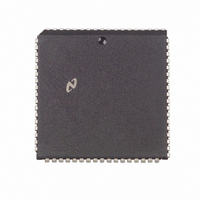DP8390DV National Semiconductor, DP8390DV Datasheet - Page 30

DP8390DV
Manufacturer Part Number
DP8390DV
Description
IC CTRLR NETWORK IN (NIC)68PLCC
Manufacturer
National Semiconductor
Datasheet
1.DP8390DN.pdf
(56 pages)
Specifications of DP8390DV
Controller Type
Network Interface Controller (NIC)
Voltage - Supply
5V
Current - Supply
40mA
Mounting Type
Surface Mount
Package / Case
68-LCC (J-Lead)
Lead Free Status / RoHS Status
Contains lead / RoHS non-compliant
Operating Temperature
-
Interface
-
Other names
*DP8390DV
Available stocks
Company
Part Number
Manufacturer
Quantity
Price
Company:
Part Number:
DP8390DV
Manufacturer:
NSC
Quantity:
5 510
Company:
Part Number:
DP8390DV
Manufacturer:
SIEMENS
Quantity:
5 510
Part Number:
DP8390DV
Manufacturer:
NS/国半
Quantity:
20 000
Company:
Part Number:
DP8390DV NS32490DV
Manufacturer:
NSC
Quantity:
5 510
Company:
Part Number:
DP8390DV NS32490DV
Manufacturer:
SUPERTEX
Quantity:
5 510
Company:
Part Number:
DP8390DV/NS32490DV
Manufacturer:
NSC
Quantity:
5 510
11 0 Initialization Procedures
(Continued)
Before receiving packets the user must specify the location
of the Receive Buffer Ring This is programmed in the Page
Start and Page Stop Registers In addition the Boundary
and Current Page Registers must be initialized to the value
of the Page Start Register These registers will be modified
during reception of packets
12 0 Loopback Diagnostics
Three forms of local loopback are provided on the NIC The
user has the ability to loopback through the deserializer on
the DP8390D NIC through the DP8391 SNI and to the coax
to check the link through the transceiver circuitry Because
of the half duplex architecture of the NIC loopback
testing is a special mode of operation with the follow-
ing restrictions
Restrictions During Loopback
The FIFO is split into two halves one used for transmission
the other for reception Only 8-bit fields can be fetched from
memory so two tests are required for 16-bit systems to veri-
fy integrity of the entire data path During loopback the maxi-
mum latency from the assertion of BREQ to BACK is 2 0 s
Systems that wish to use the loopback test yet do not meet
this latency can limit the loopback packet to 7 bytes without
experiencing underflow Only the last 8 bytes of the loop-
back packet are retained in the FIFO The last 8 bytes can
be read through the FIFO register which will advance
through the FIFO to allow reading the receive packet se-
quentially
When in word-wide mode with Byte Order Select set the
loopback packet must be assembled in the even byte loca-
tions as shown below (The loopback only operates with
byte wide transfers )
DESTINATION ADDRESS
SOURCE ADDRESS
LENGTH
DATA
CRC
Appended by NIC if CRC
e
(6 bytes) Station Physical Address
e
46 to 1500 bytes
2 bytes
l
e
‘‘0’’ in TCR
TL F 8582– 15
30
When in word-wide mode with Byte Order Select low the
following format must be used for the loopback packet
Note When using loopback in word mode 2n bytes must be programmed in
To initiate a loopback the user first assembles the loopback
packet then selects the type of loopback using the Transmit
Configuration register bits LB0 LB1 The transmit configura-
tion register must also be set to enable or disable CRC gen-
eration during transmission The user then issues a normal
transmit command to send the packet During loopback the
receiver checks for an address match and if CRC bit in the
TCR is set the receiver will also check the CRC The last 8
bytes of the loopback packet are buffered and can be read
out of the FIFO using the FIFO read port
Loopback Modes
MODE 1 Loopback Through the Controller (LB1
If the loopback is through the NIC then the serializer is sim-
ply linked to the deserializer and the receive clock is derived
from the transmit clock
MODE 2 Loopback Through the SNI (LB1
If the loopback is to be performed through the SNI the NIC
provides a control (LPBK) that forces the SNI to loopback
all signals
MODE 3 Loopback to Coax (LB1
Packets can be transmitted to the coax in loopback mode to
check all of the transmit and receive paths and the coax
itself
Note In MODE 1 CRS and COL lines are not indicated in any status regis-
Reading the Loopback Packet
The last eight bytes of a received packet can be examined
by 8 consecutive reads of the FIFO register The FIFO
pointer is incremented after the rising edge of the CPU’s
read strobe by internally synchronizing and advancing the
pointer This may take up to four bus clock cycles if the
pointer has not been incremented by the time the CPU
reads the FIFO register again the NIC will insert wait states
Note The FIFO may only be read during Loopback Reading the FIFO at
e
1)
TBCR0 1 Where n
odd location
ter but the NIC will still defer if these lines are active In MODE 2
COL is masked and in MODE 3 CRS and COL are not masked It is
not possible to go directly between the loopback modes it is neces-
sary to return to normal operation (00H) when changing modes
any other time will cause the NIC to malfunction
e
actual number of bytes assembled in even or
e
1 LB0
e
e
1 LB0
1)
TL F 8582– 16
e
0 LB0
e
0)












